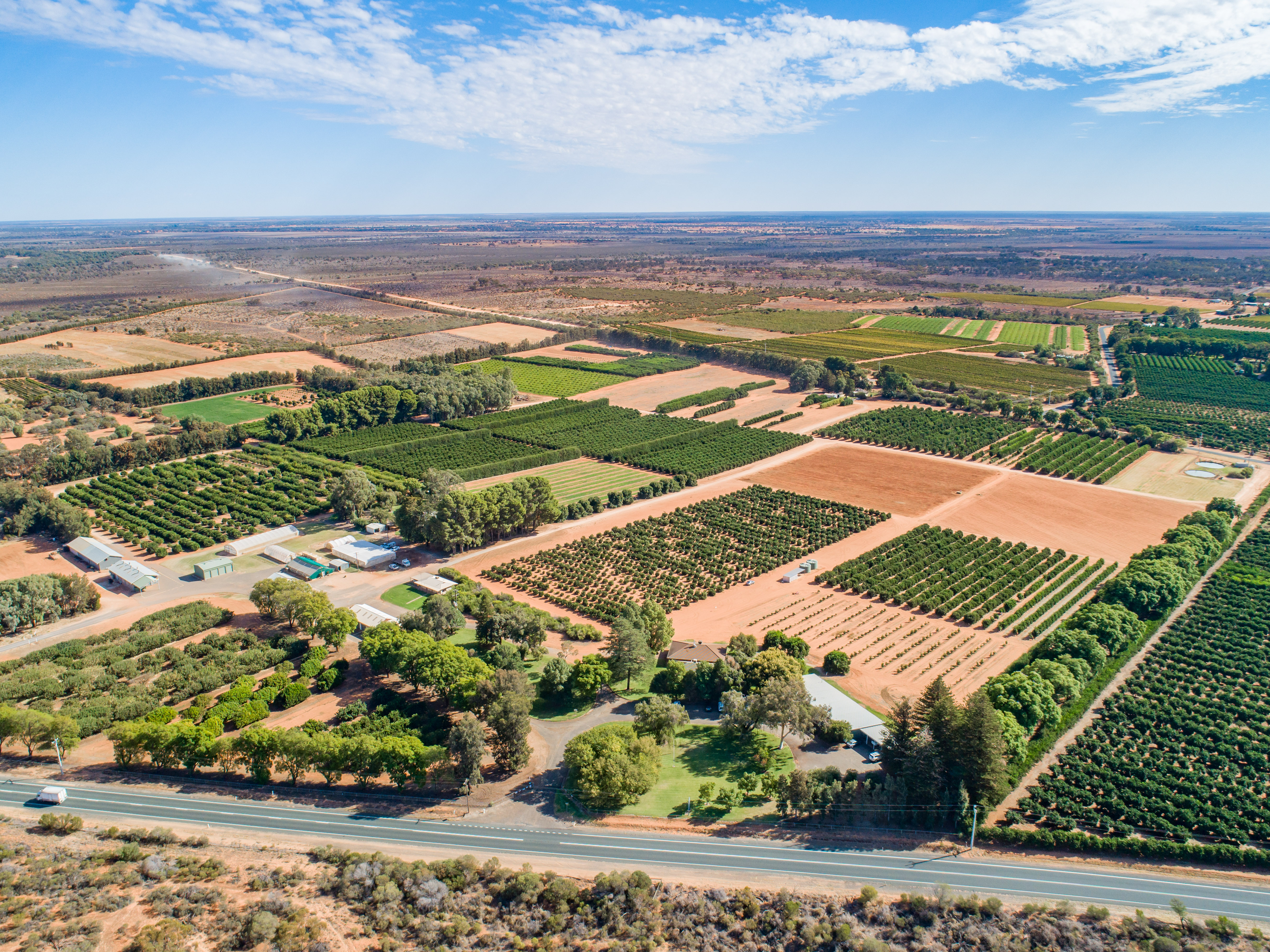Overview
The town of Dareton is at the centre of the Coomealla Irrigation Area, an ambitious horticultural development which began in 1922. The bush landscape was transformed into an orderly pattern of vineyards and orchards, by soldier settlers, following the two world wars.
The Dareton Primary Industries Institute is located on 243 ha in the major fruit growing area of the Lower Murray Darling region. About one-third of the site’s area has soils suitable for horticulture.
This rich and progressive fruit-growing area forms part of the intensively developed Sunraysia District of New South Wales and Victoria, and the Riverland area of South Australia:
- The main horticultural industries are grape (wine, dried and table), citrus and almonds.
- Minor crops include avocados and pistachios.
Research at the Institute is primarily directed at improving the sustainability of citrus production and has some of the oldest citrus varieties planted in 1955 trials, along with old varieties of trees that you cannot find anywhere else in Australia.
Our research
The Institute’s primary research focus is on improving the sustainability of the citrus industry.
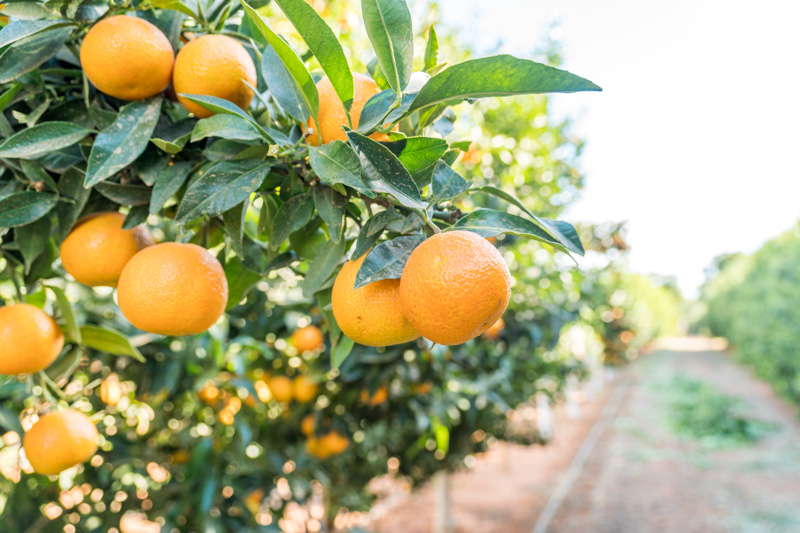
Visit, events and more
Located in the major fruit growing area of the Lower Murray Darling region, the Institute experiences warm summers and mild winters.
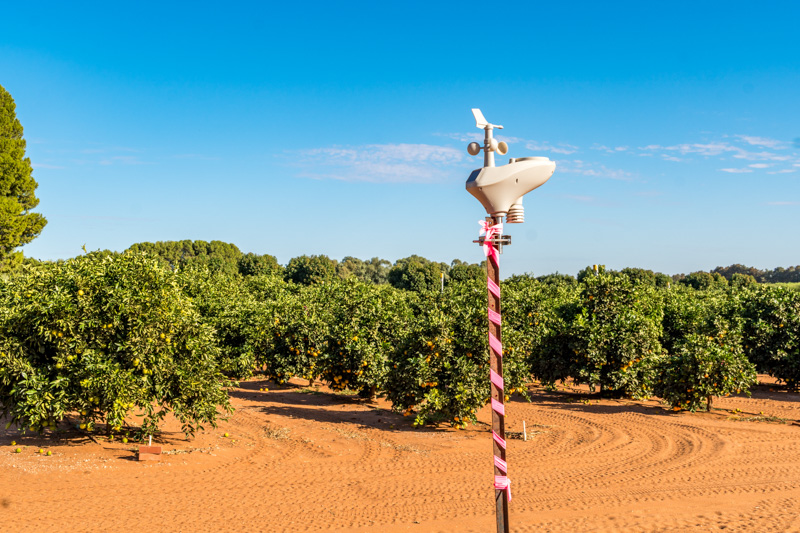
Citrus
Citrus research has dominated across the property since its founding in 1955, and the majority of our work today is based on a long-term commitment to industry. Both our variety and rootstock evaluation programs on site have run continuously for more than 20 years.
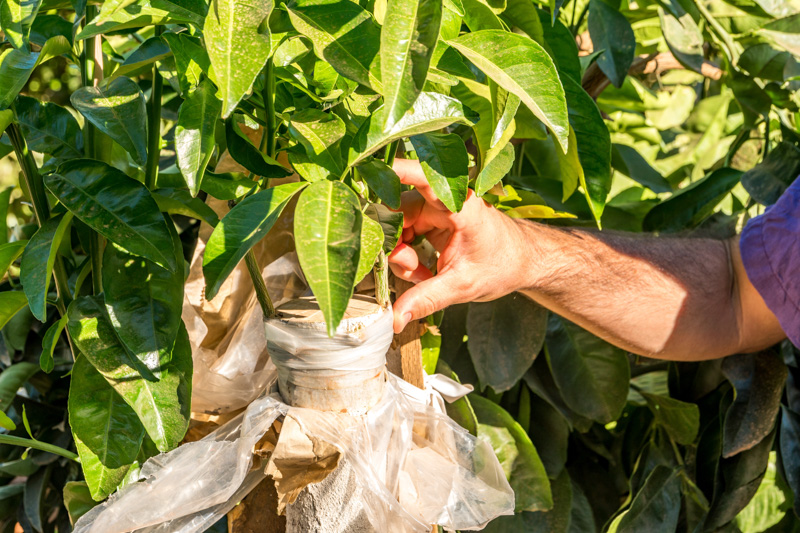
Persimmons
Persimmon research is a relatively new area for the Institute, but draws heavily on our expertise with other crops.
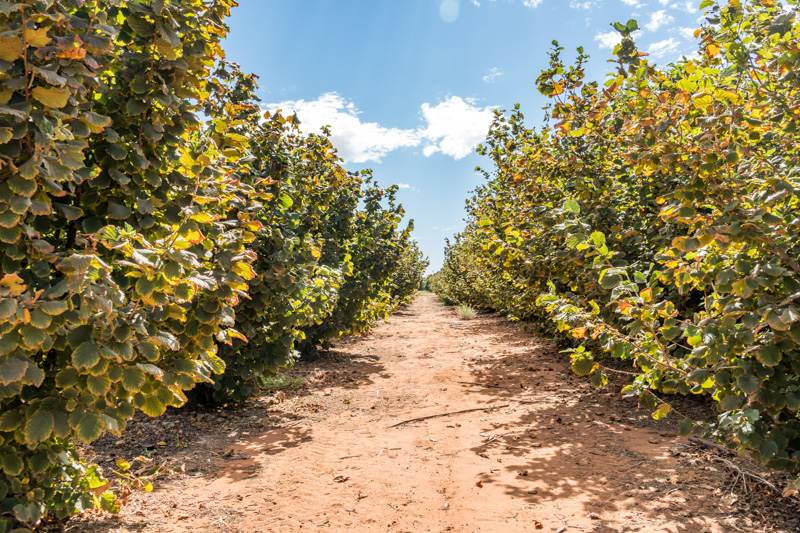
Hazelnuts
Hazelnuts are one of the fastest growing tree nut industries in Australia, with planting area increasing from 150 ha to 2150 ha since 2011.
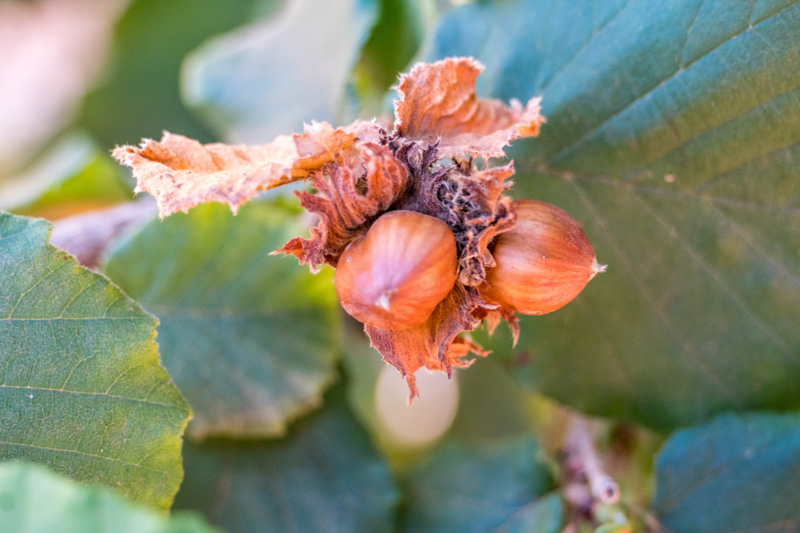
National Germplasm collection
The national germplasm collection of grapevine varieties was also established at Dareton for the Australian Vine Improvement Association with initial plantings in 2003.
Work with us
If you would like to utilise our research facilities or services, or explore partner and -co-location opportunities please fill out this Request for Opportunity Form
Research station request for opportunity formOur region
The value of agricultural production in the Lower Murray Sub Region was over $290 million (ABS 2015/16) from a range of broadacre cereal crops, beef, wool, sheep and lambs, and fruit, grapes and nuts. The Lower Murray supplies nearly 50% of NSW GVP grapes and 8% of NSW GVP of fruit and nuts.
The Lower Murray contains some highly productive agricultural land of the Murray Darling Basin. The variety of landscapes supports a diverse range of agricultural industries that all place a high value on reliable water supplies. Key agricultural enterprises includes broadacre cropping (cereals), horticulture, and rangeland sheep grazing. Irrigation sustains horticultural industries along the Murray and Darling Rivers and tributaries.
The Lower Murray is a premium agricultural area, leading the way in agricultural innovation and value-adding, and leveraging advanced and automated technologies to maximise agribusiness diversification. The agricultural industry in the Lower Murray is diverse, producing grains, fruit and nuts, wool and meats from sheep, cattle, goats and kangaroos. The value chain is concentrated in and around Mildura and Swan Hill, although also locally significant in Balranald and Wentworth. Similarly agricultural services and infrastructure and specifically, irrigation water delivery companies and equipment suppliers are provided through North West Victoria with support services in the NSW centres.
Production figures for "Western" LLS area, sourced from the ABS 2022:
| Wheat | 182,429,203 | 5% |
| Sheep and lambs | 162,526,154 | 13% |
| Grapes - Wine production | 122,494,257 | 49% |
| Cattle and calves | 109,204,731 | 4% |
| Wool | 99,851,899 | 12% |
| Cotton | 94,818,907 | 10% |
| Oranges | 90,007,289 | 28% |
| Grapes - other uses | 71,378,549 | 95% |
| Almonds | 53,123,415 | 41% |
| Poultry | 45,748,637 | 6% |
| Total primary industries | 1,281,288,536 | 7% |
Climate
The climate is dry with warm to hot summers and mild winters. Our temperature range can be as high as 45°C in summer to a minimum of -2°C in winter.
Average total rainfall is 280 mm. Rainfall is evenly distributed throughout the year; however, there are proportionally more wet days per month during winter. Heavy rains in late January to March can reduce grape yields.
Evaporation is high at 2400mm per year. Mild frosts occur during the winter months.
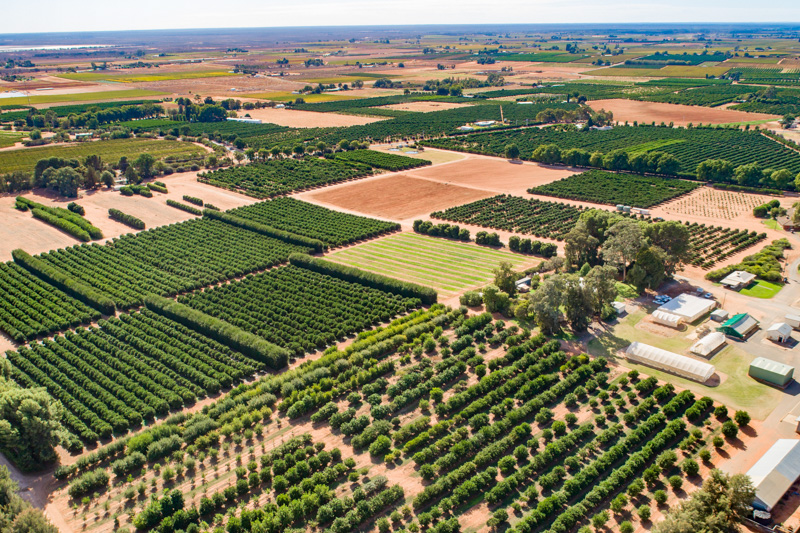
Our history
A Legacy of Innovation and Growth
The Dareton Primary Industries Institute holds a special place in the hearts of horticulturists and researchers as it reaches a significant milestone - its 75th Anniversary. Since its establishment, the Research Station has been a hub of scientific exploration, innovation, and growth.
Getting the idea off the ground
The idea of an Experimental Farm was first conceived by settlers in 1890, but it wasn't until 1925 that the matter gained traction. Mr. Searcy, the Resident Engineer, discussed the proposal with the FGA Advisory Board, and they agreed to conduct experiments on poorer classes of soil. It was decided to explore the viability of rice, cotton, and castor oil plants. However, due to the frequency of required water pumping, rice cultivation was deemed unfeasible in the region. The focus then shifted to fruit trees.
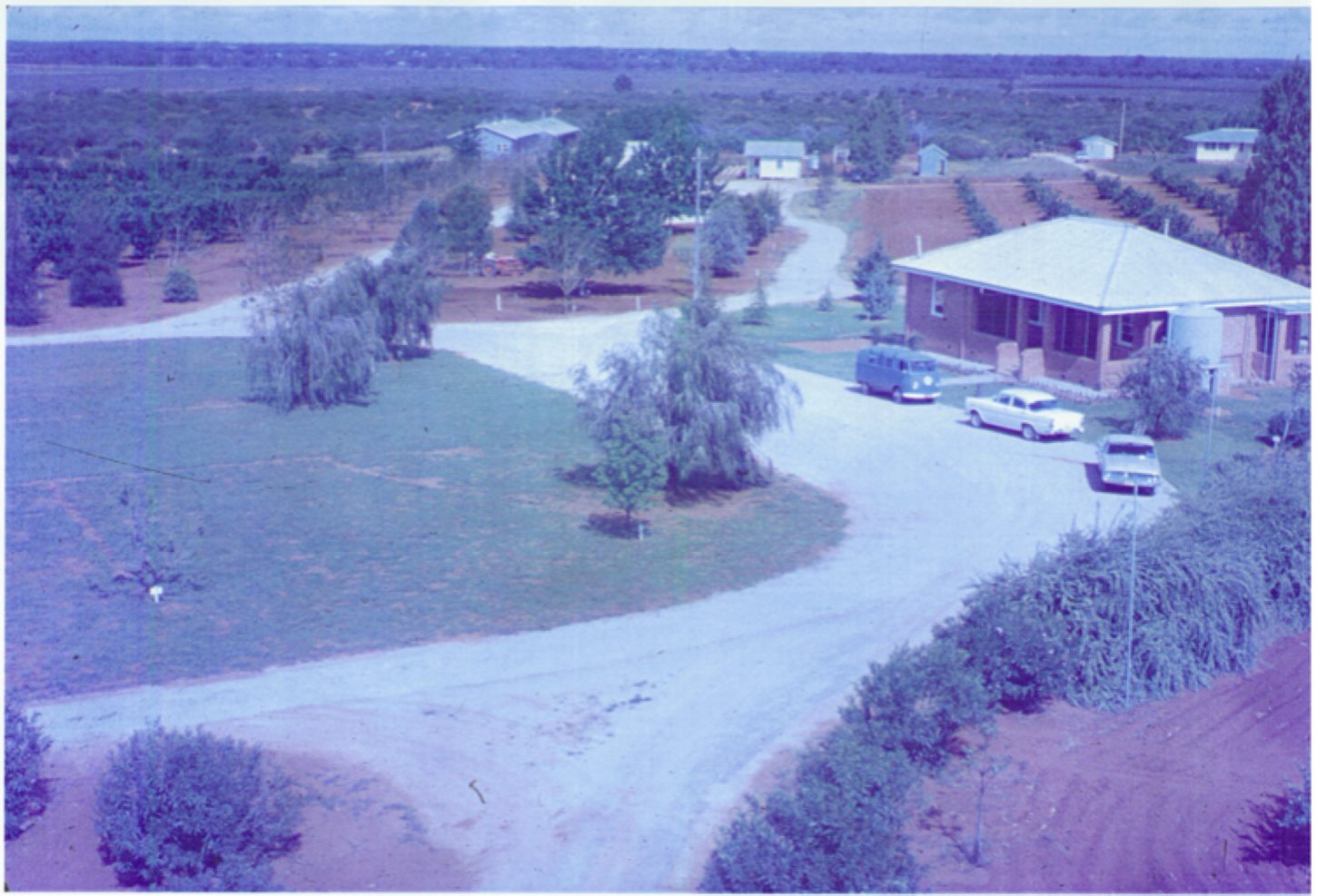
In the early 1930s a group of passionate citrus growers again expressed their interest in advancing horticultural research to boost productivity and overcome challenges in the Murray Valley. This initial spark ignited the collaboration between two remarkable individuals, Fred Oldham and Fred Barrett, who played pivotal roles in making the Research Station a reality.
Fred Oldham, a District Fruit Officer, joined the Department in 1933 and, with Fred Barrett, the Manager of the Water Conservation & Irrigation Commission, embarked on a journey that would transform a barren hill into a thriving research station.
Their efforts led to the withdrawal of the original property lease on the land to be developed, ensuring its availability for the Research Station's establishment. The property covered 240 ha, with approximately one-third of the area suitable for horticulture. Only with the Freds’ active involvement would the Research Station become a reality.
The Research Station
Before we continue, a word on naming. The property at 1998 Silver City Highway, Dareton, 2717, NSW was founded with the name Coomealla Research Station, sometimes referred to as Coomealla Horticultural Research Station, and was known to staff and growers (who we now call stakeholders) as The Research Station. In 1956 there was a flurry of communication drawing attention to the fact The Research Station was, in fact, in the Curlwaa district, and not Coomealla. It was decided that The Research Station would be renamed the Lower Murray Research Station to avoid the confusion. The name was changed again between 1956 and 1967, when The Research Station became known as the Dareton Research Station. Following the inclusion of the department's district advisory service, The Research Station changed its name to the Dareton Agricultural Research and Advisory Station (DARAS). In the mid-2000s, we had our most recent name change, and is known now as the Dareton Primary Industries Institute (DPII) – but everyone still calls it The Research Station.
Irrigation and development
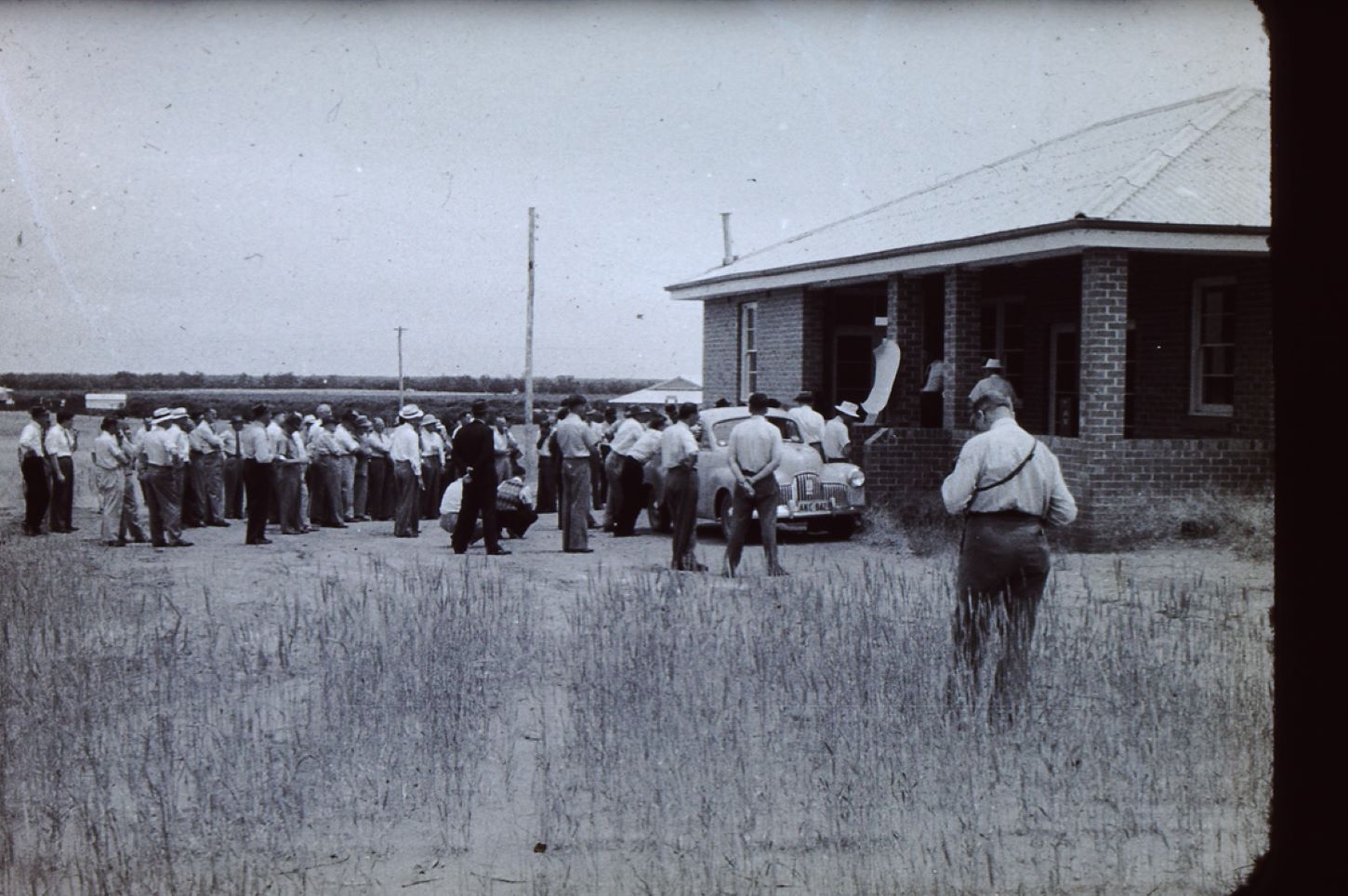 The region's climate posed unique challenges, with low average rainfall of less than 300 mm annually. As a result, irrigation became crucial for fruit production. The Water Conservation and Irrigation Commission provided a water supply, which the Research Station accessed through underground pipelines starting in 1955. To effectively manage drainage, an independent deep drainage disposal system was constructed.The
The region's climate posed unique challenges, with low average rainfall of less than 300 mm annually. As a result, irrigation became crucial for fruit production. The Water Conservation and Irrigation Commission provided a water supply, which the Research Station accessed through underground pipelines starting in 1955. To effectively manage drainage, an independent deep drainage disposal system was constructed.The
Research Station's transformation from a barren hill to a thriving research hub began in earnest in the 1950s. With the construction of an administration building, workshop, machinery shed, store, and cottage in 1951, the groundwork was laid for future growth. Progress continued, including connecting electric lighting and power in 1954.
Expanding to meet industry needs
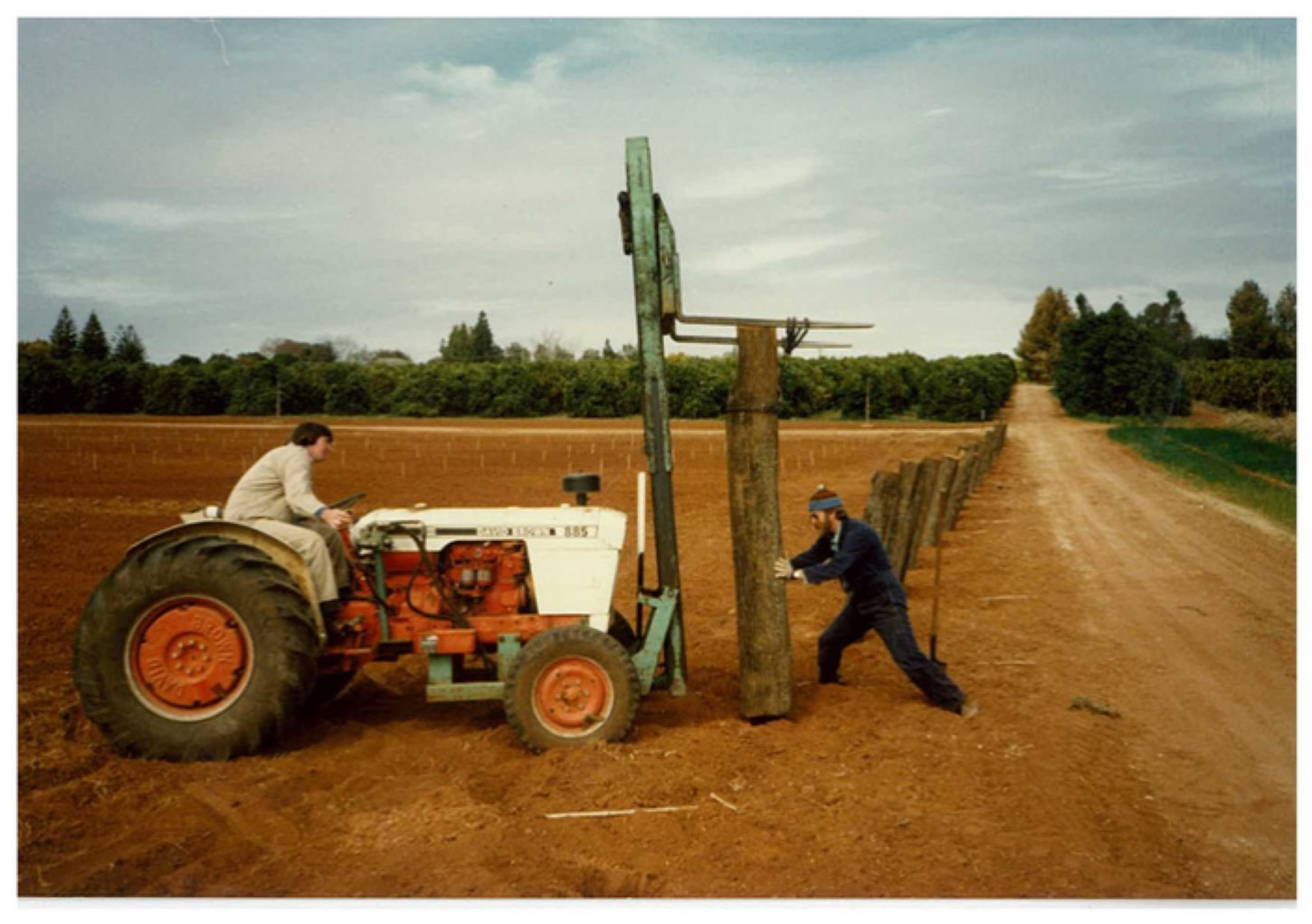 Over the years, the acreage dedicated to research and cultivation steadily expanded. Citrus emerged as the dominant crop, and research efforts were primarily focused on addressing challenges specific to citrus cultivation. Additionally, a stone fruit demonstration block was established to showcase different varieties' performance under local conditions. In 1964, sultana planting began and started investigations into various aspects of viticulture.
Over the years, the acreage dedicated to research and cultivation steadily expanded. Citrus emerged as the dominant crop, and research efforts were primarily focused on addressing challenges specific to citrus cultivation. Additionally, a stone fruit demonstration block was established to showcase different varieties' performance under local conditions. In 1964, sultana planting began and started investigations into various aspects of viticulture.
The year 1965 witnessed a crucial milestone as Mike Stannard became the first research officer appointed to The Research Station, bringing fresh perspectives and expertise to the team. Over the following years, under Mike's leadership, the Research Station flourished. He served as Acting Manager during Jack Turpin's secondment to Head Office and later took over as Manager in August 1967. During this transformative period, horticultural research plantings doubled, thanks to the meticulous plans laid out by Jack. The expansion required doubling irrigation installations and extensive tile drainage efforts.
Research
The research conducted at DPII has been marked by long-term experiments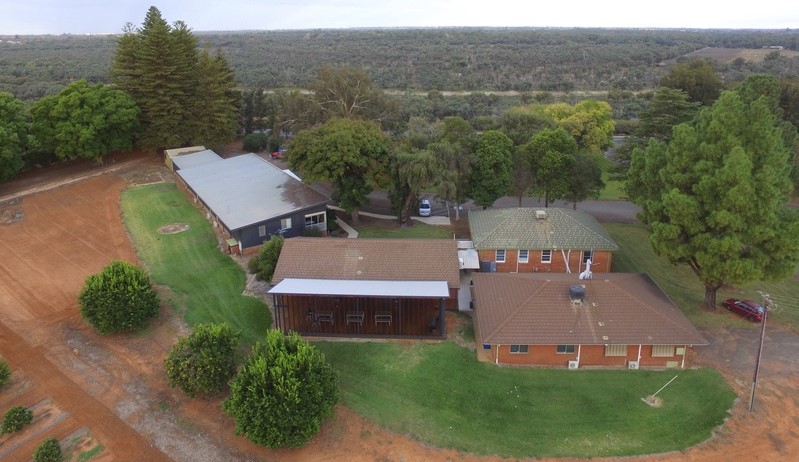 and ground-breaking studies. These experiments have tackled specific challenges and spanned several years to yield meaningful results. The stem-pit experiment focused on testing whether virus-free trees could be inoculated with a mild strain virus to protect them from the severe form.
and ground-breaking studies. These experiments have tackled specific challenges and spanned several years to yield meaningful results. The stem-pit experiment focused on testing whether virus-free trees could be inoculated with a mild strain virus to protect them from the severe form.
The Citrus Nutrition Trial focused on optimizing nutrient management to enhance crop yields and fruit quality. Additionally, the establishment of the Citrus Mother Tree Block ensured the availability of healthy and disease-resistant plant material for growers. In 2009, AusCitrus, the Australian high health-status propagation material supply scheme, opened their River Road, Coomealla, property, establishing their own mother tree blocks. The strong relationship between AusCitrus and the DPII continues today.
Environmental sustainability also emerged as a priority. A chance encounter between Mike Stannard and Horticulture Chief Bob Kebby led to the introduction of hybrid sorghum windbreaks to protect young plantings from sandblast. This innovative solution prompted the widespread adoption of Barner grass windbreaks throughout Sunraysia, ensuring long-lasting protection against the elements while offering ease of maintenance. Over the years, DPII expanded its research areas to include irrigation management, salinity control for citrus, vines, and vegetables, planting density, tree size control for citrus, propagation of citrus, and nutrition of asparagus and melons.
A strong focus on collaboration
In 1967, the department's district advisory service was relocated to The Research Station following the construction of an office building, creating an integrated research and extension service, prompting a name change from the Dareton Research Station to the Dareton 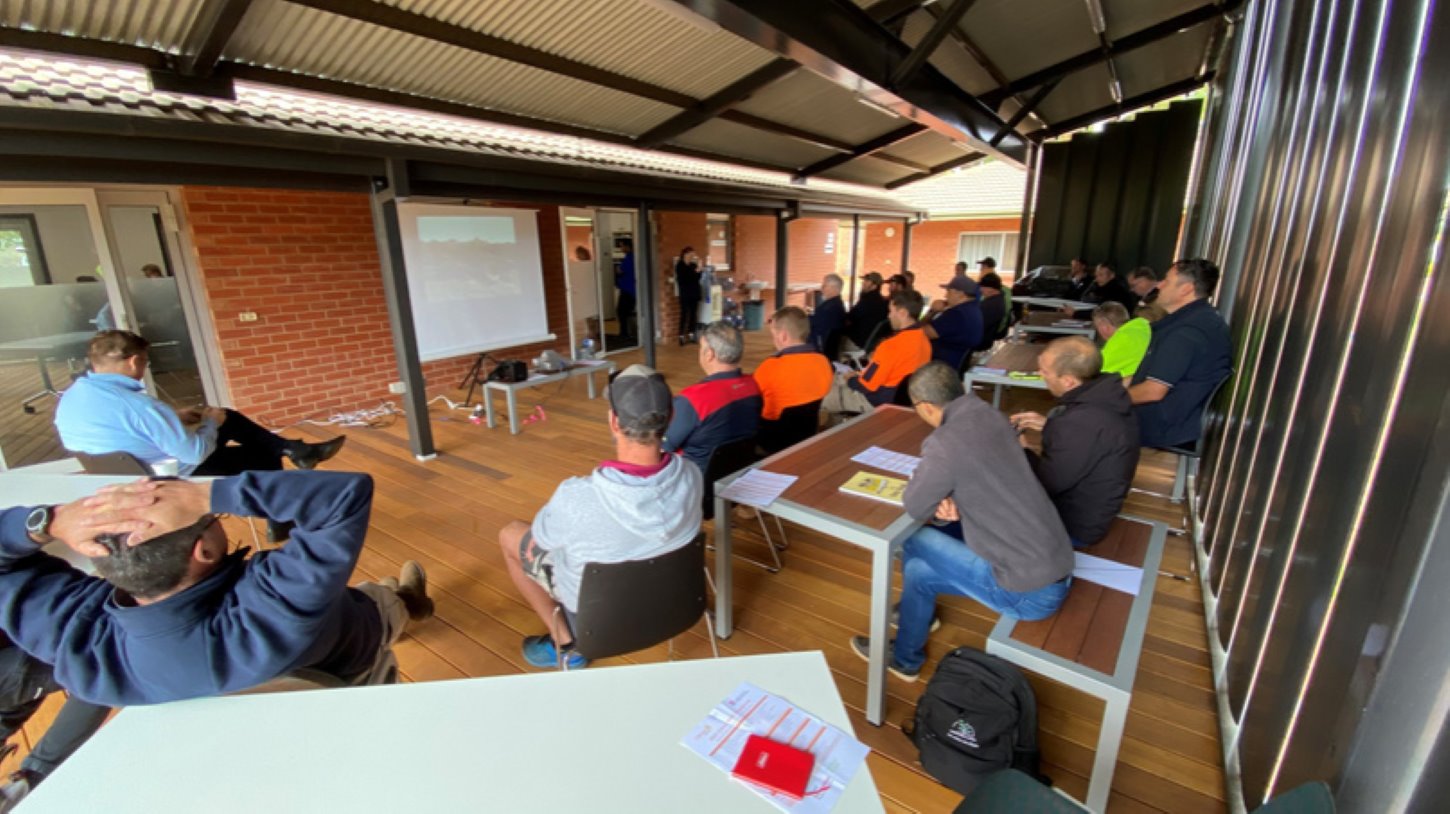 Agricultural Research and Advisory Station. In the early 1980s the Community Employment Program was introduced by the Commonwealth Government. This program financed, in part, a new office and laboratory building for research staff, and a new conference room which is used for grower meetings, small workshops and seminars.
Agricultural Research and Advisory Station. In the early 1980s the Community Employment Program was introduced by the Commonwealth Government. This program financed, in part, a new office and laboratory building for research staff, and a new conference room which is used for grower meetings, small workshops and seminars.
The appointment of an Irrigation Officer to the staff at Dareton in May 1987 allowed The Research Station to expand its value to the community by providing a technically-based pool of knowledge until the service’s closure in 2013. Fisheries and Forestry officers were co-located at The Research Station following the merging of departments in 2004, and Public Works have had staff on the property for a similar time. Our last veterinarian retired in 2018.
In addition to the industry co-funded research we focus on now, The Research Station was an integral part of the Riverlink network. Formed in 1991, Riverlink had wide inter-agency collaboration with CSIRO, Agriculture Victoria, the South Australian Agriculture Department and the New South Wales Department of Primary Industries. The program helped integrate programs and service delivery across major horticultural centres in the Sunraysia-Riverland region.
Dareton Primary Industries Institute Station Video
Contact
Address
1998 Silver City Highway
DARETON NSW 2717
Postal address:
Dareton Primary Industries Institute
PO Box 62
Dareton NSW 2717
Contact
Phone: (03) 5019 8400
International: +61 3 5019 8400
Fax: (03) 5027 4319
